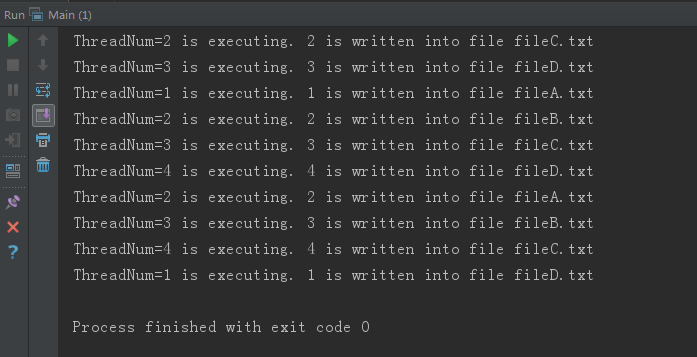有四個執行緒1、2、3、4,執行緒1的功能就是輸出1,執行緒2的功能就是輸出2,以此類推......... 現在有四個檔案A B C D,初始都為空。現要讓四個檔案呈如下格式:A:1 2 3 4 1 2..
阿新 • • 發佈:2019-02-05
具體題目如下:
有四個執行緒1、2、3、4,
執行緒1的功能就是輸出1,執行緒2的功能就是輸出2,以此類推.........
現在有四個檔案A B C D,
初始都為空。現要讓四個檔案呈如下格式:
A:1 2 3 4 1 2....
B:2 3 4 1 2 3....
C:3 4 1 2 3 4....
D:4 1 2 3 4 1....
以上就是我看到的一個多執行緒相關的面試題,看完了 ,就想想怎麼實現。
下面就看程式碼
理論上講,都是從main方法走起,
package com.lxk.threadTest.mianShiTest.googleTest; import java.util.concurrent.ExecutorService; import java.util.concurrent.Executors; /** * 有四個執行緒1、2、3、4。 * <p> * 執行緒1的功能就是輸出1,執行緒2的功能就是輸出2, * <p> * 以此類推......... 現在有四個檔案A B C D, * 初始都為空。現要讓四個檔案呈如下格式: * A:1 2 3 4 1 2.... * B:2 3 4 1 2 3.... * C:3 4 1 2 3 4.... * D:4 1 2 3 4 1.... * <p> * Created by lxk on 2017/7/14 */ public class Main { public static void main(String[] args) { FileWriteUtil util = new FileWriteUtil(); ExecutorService service = Executors.newCachedThreadPool(); service.execute(new WriteRunnable(util, 1, '1')); service.execute(new WriteRunnable(util, 2, '2')); service.execute(new WriteRunnable(util, 3, '3')); service.execute(new WriteRunnable(util, 4, '4')); service.shutdown(); //new Thread(new WriteRunnable(util, 1, '1')).start(); //new Thread(new WriteRunnable(util, 2, '2')).start(); //new Thread(new WriteRunnable(util, 3, '3')).start(); //new Thread(new WriteRunnable(util, 4, '4')).start(); } }
上面關於啟動執行緒,有2中方式,
第一種,也就是未註釋的,略顯高階點,看類名大概就知道使用的是個執行緒池的東西。這個實現姿勢有很多種。這只是其中的一個。
第二種,也就是下面註釋的程式碼,也不low,是我們常見的啟動執行緒 的方式。
然後就是我們說的那個實現多執行緒的類的實現啦
package com.lxk.threadTest.mianShiTest.googleTest; /** * Created by lxk on 2017/7/14 */ public class WriteRunnable implements Runnable { private final FileWriteUtil util; private int threadNum; private char value; /** * @param util 寫檔案工具類 * @param threadNum 執行緒號 * @param value 寫的字元 */ public WriteRunnable(FileWriteUtil util, int threadNum, char value) { this.util = util; this.threadNum = threadNum; this.value = value; } public void run() { /* * 假設迴圈6次,一直迴圈可以使用while(true)或者for(;;) */ for (int i = 0; i < 6; i++) { synchronized (util) { while (threadNum != util.getCurrentThreadNum()) { try { util.wait(); } catch (InterruptedException e) { e.printStackTrace(); } } util.write(value, threadNum); util.notifyAll(); } } } }
最後,就是這個寫檔案的類啦。
package com.lxk.threadTest.mianShiTest.googleTest; import java.io.FileWriter; import java.io.IOException; /** * 此類,是四個執行緒共享的, * <p> * Created by lxk on 2017/7/14 */ public class FileWriteUtil { private int currentThreadNum = 1; /** * 記錄將字元寫入檔案的次數 */ private int count = 0; private String currentFileName; public void write(char value, int threadNum) { getCurrentFileName(); FileWriter writer = null; try { //生成檔案位置 writer = new FileWriter("D:/test/test/" + currentFileName + ".txt", true); writer.write(value + " "); System.out.printf( "ThreadNum=%d is executing. %c is written into file file%s.txt \n", currentThreadNum, value, currentFileName); writer.flush(); //System.out.println(count);// count++; currentThreadNum = threadNum; } catch (IOException e) { e.printStackTrace(); } if (null != writer) { try { writer.close(); } catch (IOException e) { e.printStackTrace(); } } getNextThreadNum(); } public int getCurrentThreadNum() { return currentThreadNum; } public void setCurrentThreadNum(int currentThreadNum) { this.currentThreadNum = currentThreadNum; } /** * 根據寫的次數,判斷該寫哪個檔案了?A,B,C,D. */ private void getCurrentFileName() { int temp = count % 4; switch (temp) { case 0: currentFileName = "A"; break; case 1: currentFileName = "B"; break; case 2: currentFileName = "C"; break; case 3: currentFileName = "D"; break; default: currentFileName = "E"; } } private void getNextThreadNum() { if (count % 4 == 0) { if (currentThreadNum < 3) { currentThreadNum += 2; } else { currentThreadNum = (currentThreadNum + 2) % 4; } } else { if (currentThreadNum == 4) { currentThreadNum = 1; } else { currentThreadNum++; } } } }
最後,就是看下程式碼實際執行的結果。
從列印結果看,看到了是四個執行緒在跑,而且分別寫入到ABCD四個檔案去。
注意,圖中的紅線框,奧,也可以不注意啦。
其實,說得最透徹點,就是這四個執行緒,輪著執行,
每次,都是有一個執行緒可以執行,這的執行也就是寫檔案啦,然後其他的三個都稍息,也是wait()啦。
等這個執行緒執行完畢之後,也就是寫檔案完畢之後,喚醒另外三個在wait()的執行緒,然後,設定一下,下一個可以處於執行態的執行緒,然後又開始重複了。
不能執行的,都wait(),如此往復。
這裡有個需要注意的是。
這四個執行緒都在共享操作的就是那個寫檔案工具類。也就是對這個上鎖。四個執行緒用的是一個鎖,那就可以保證執行緒安全啦。
理論,是這個理論,但是,真讓你寫,可不一定能分分鐘就寫好。


